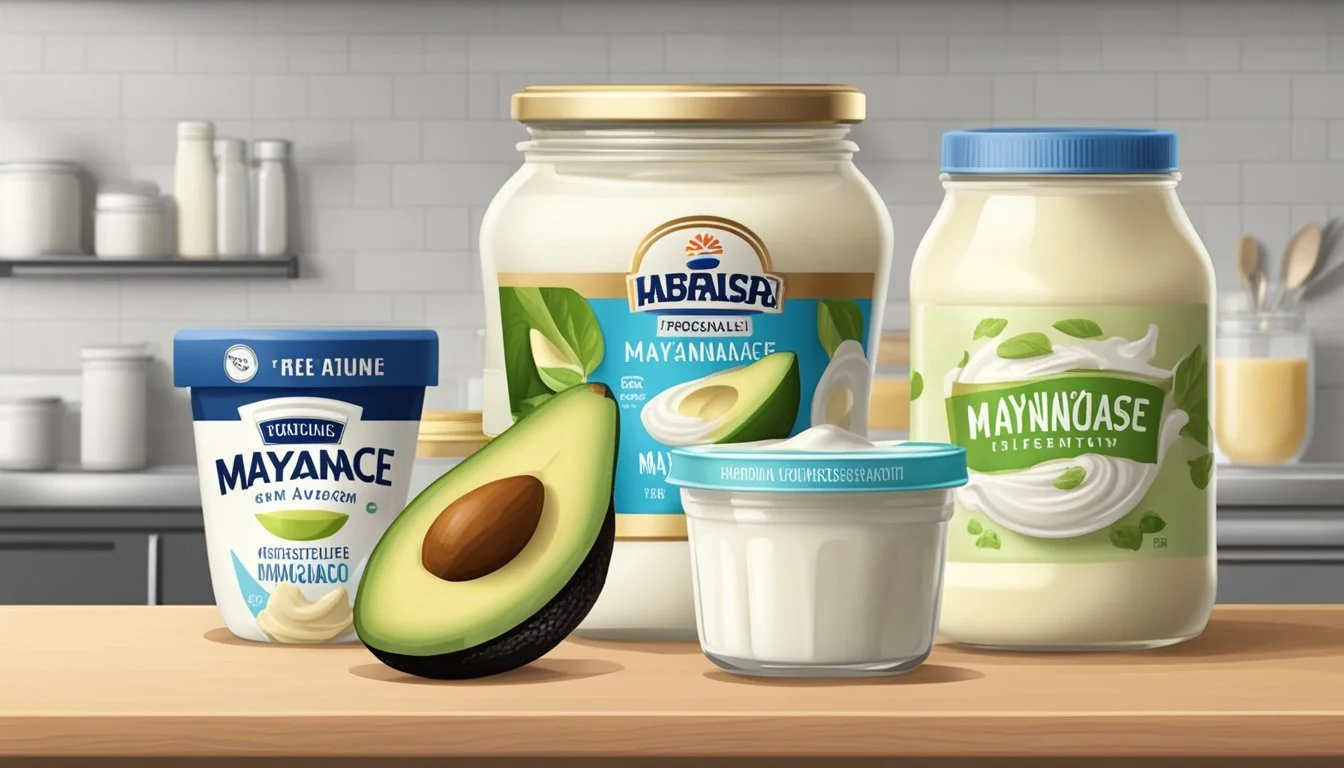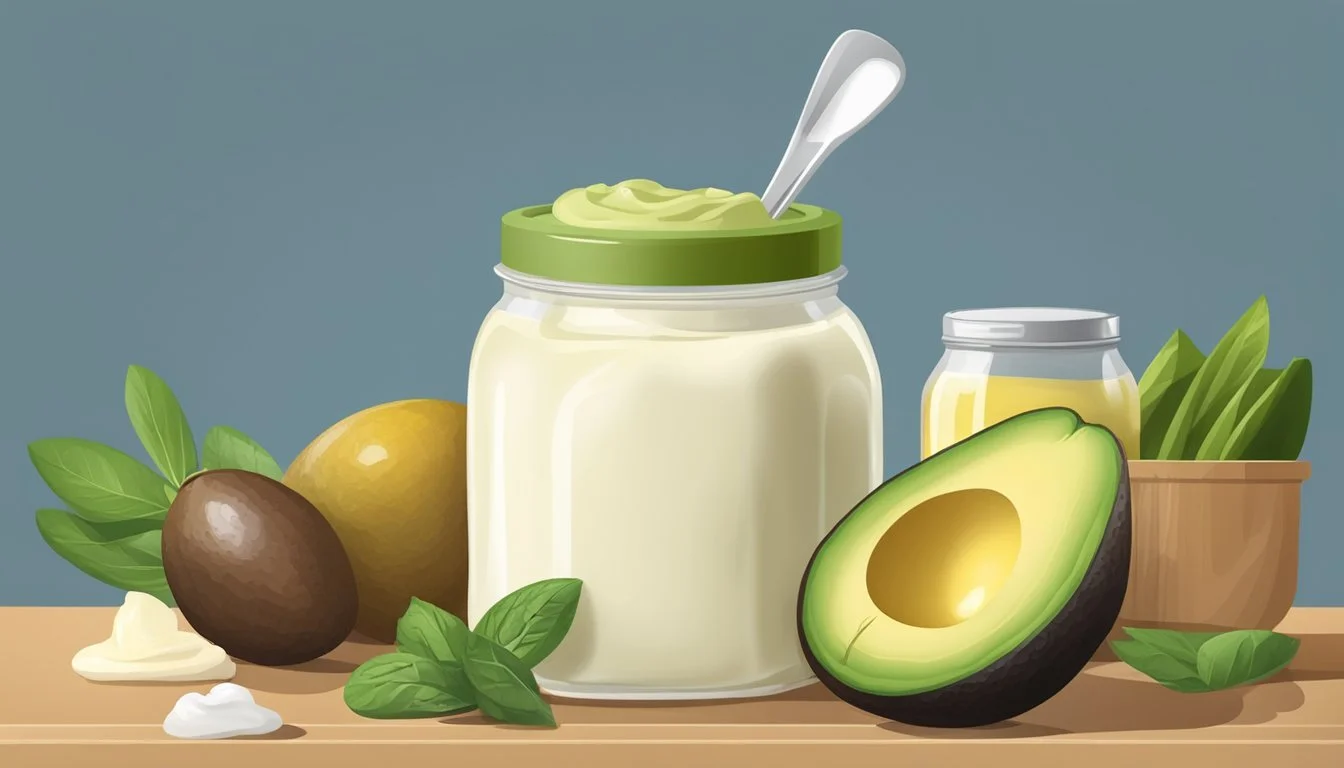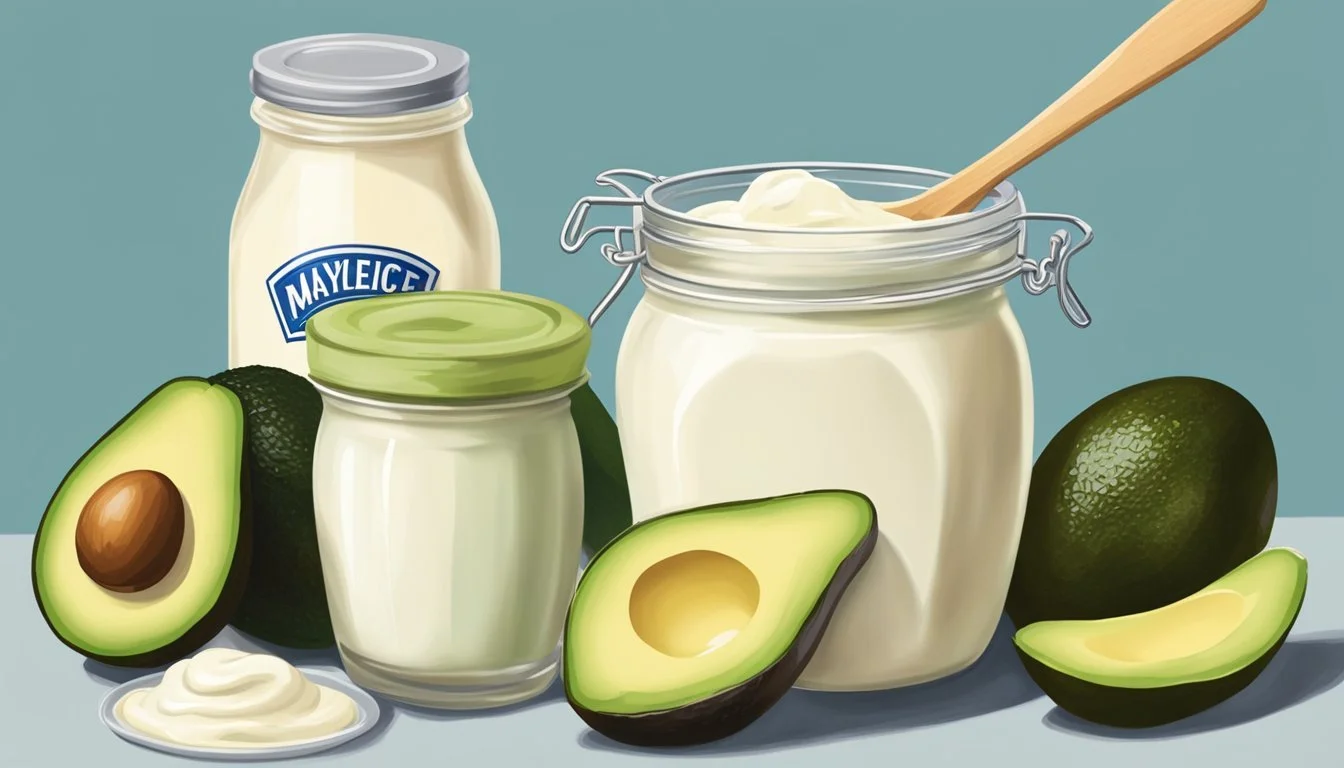Mayonnaise Substitutes
Top Healthy and Tasty Alternatives
Mayonnaise has long been a staple in kitchens for its creamy texture and versatile flavor, enhancing sandwiches (What wine goes well with sandwiches?), salads (What wine goes well with salads?) , and dips alike. However, dietary preferences and health considerations often prompt the search for suitable alternatives. A variety of mayonnaise substitutes exist, each offering distinct nutritional profiles and culinary uses that cater to different needs. These alternatives not only accommodate dietary restrictions but also provide an opportunity to experiment with new flavors and textures in traditional recipes.
Substitutes such as Greek yogurt and sour cream offer a similar creaminess with a tangy twist, often containing less fat and more protein compared to traditional mayonnaise. For those seeking plant-based options, avocado and hummus present themselves as popular choices, delivering a rich consistency along with beneficial fats and nutrients. When substituting mayonnaise, it is crucial to consider the intended purpose in the recipe, as some alternatives may alter the flavor profile or behave differently when cooked.
Understanding Mayonnaise
Mayonnaise is a condiment recognized for its smooth texture and distinct taste. This section provides an in-depth look at its composition and various culinary applications.
Composition of Mayonnaise
Mayonnaise principally consists of egg yolks, oil, usually vegetable or olive oil, and an acid typically in the form of lemon juice or vinegar. These ingredients are emulsified, meaning the oil is finely dispersed in the water from the other ingredients and held stable by the lecithin in egg yolks. Salt is often added to enhance the flavor. The precise balance of these components contributes to mayonnaise's thick, creamy texture and its rich taste that can also incorporate subtle tanginess from the acid.
Culinary Uses of Mayonnaise
Mayonnaise serves a versatile role in the culinary world, functioning both as a base for various sauces and dressings and as a condiment in its own right. It's commonly spread on sandwiches and burgers, contributing moisture and flavor. Additionally, its creamy consistency is essential in salads such as potato salad, egg salad, and tuna salad. It can also be used in cooking, where it provides moisture and a golden crust when baked onto foods like chicken.
Health Considerations
When considering health implications, mayonnaise substitutes can vary widely in terms of fat content and calories, suitability for vegan and egg-free diets, and the health benefits or drawbacks of homemade versus store-bought options.
Fat Content and Calories
Mayonnaise is known for its high fat content, which contributes to its calorie density. Substitutes like low-fat cottage cheese offer a reduction in fat content and calories. For instance, where traditional mayonnaise contains about 10 grams of fat and 94 calories per tablespoon, low-fat cottage cheese can contain as little as 1 gram of fat and 20 calories per tablespoon.
Traditional Mayonnaise: ~10g fat, 94 calories (per tablespoon)
Low-fat Cottage Cheese: ~1g fat, ~20 calories (per tablespoon)
Vegan and Egg-Free Options
Mayonnaise typically includes eggs, which are not suitable for a vegan diet or for individuals with egg allergies. Vegan mayonnaise substitutes, such as mashed avocado and hummus, exclude eggs and often incorporate ingredients like chickpeas, tahini, and various oils to create a creamy texture similar to mayonnaise. These options not only comply with vegan and egg-free diets but also contribute beneficial nutrients like healthy fats.
Avocado: Rich in monounsaturated fats, egg-free, vegan-friendly
Hummus: Made from chickpeas, contains protein, egg-free, vegan-friendly
Homemade vs. Store-Bought
Homemade mayonnaise substitutes can be healthier than store-bought versions, which often contain added sugars, preservatives, and stabilizers like high fructose corn syrup. Creating a homemade option allows for control over ingredients and the exclusion of unhealthy additives. In contrast, some store-bought mayo substitutes may advertise being a healthier alternative but still include undesirable ingredients.
Homemade: Control over ingredients, no high fructose corn syrup
Store-Bought: May contain added sugars and preservatives
Mayonnaise Substitutes
When seeking to replace mayonnaise, one should consider the desired taste and texture, as well as the context of use, whether it's for spreads, dressings, or cooking. Alternatives range from dairy and plant-based substitutes to oil-based variants, and each comes with its unique flavor profile and culinary applications.
Dairy-Based Alternatives
Sour cream and Greek yogurt are excellent mayonnaise substitutes, offering a creamy texture with a tangy flavor. They can be used in dressings, dips, and as spreads. Cottage cheese, when blended until smooth, also serves as a lower-fat option with a mild taste suitable for salads and sandwich fillings.
Sour Cream: Adds a fresh zip to recipes and can substitute mayonnaise in a 1:1 ratio.
Greek Yogurt: Provides protein and reduces calories, ideal for a healthier spread or dressing.
Cottage Cheese: Blends into a smooth consistency, perfect for dips when seeking less fat.
Plant-Based Substitutes
For those following a vegan diet or for anyone interested in plant-based alternatives, products like vegan mayo and avocado mayo mimic traditional mayonnaise while avoiding animal products. Tahini and nut butter can offer a richer, nuttier flavor compared to the mild profile of mayonnaise.
Vegan Mayo: Utilizes plant-based ingredients, serving as a direct substitute for mayonnaise.
Avocado Mayo: Incorporates avocados, imparting a creamy texture and a hint of natural green color.
Tahini: Made from sesame seeds, ideal for dressings and meals requiring a nuttier taste.
Nut Butter: Best for sandwiches and has a thicker consistency, often requiring thinning for use in dressings.
Oil-Based Variants
Replacing mayonnaise with a straight oil like olive oil or vegetable oil can work particularly well in dressings. These oils provide a smooth consistency and can be emulsified to mimic the texture of mayonnaise.
Olive Oil: Offers a heart-healthy alternative with a distinctive flavor, suitable for vinaigrettes.
Vegetable Oil: Has a neutral taste and serves as a versatile base for creating homemade mayo-like emulsions.
Miscellaneous Options
Butter and cream cheese serve as unique mayonnaise substitutes, with butter adding a richness to cooked dishes and cream cheese offering a thick spreadability for cold recipes.
Butter: Best used melted in warm dishes where a creamy texture and rich flavor are desired.
Cream Cheese: A good spread for bagels and sandwiches, it provides a thickness and creaminess with a mild tang.
Substitute Applications
When replacing mayonnaise in recipes, the chosen substitute should complement the dish's flavor and consistency requirements. Each application demands a particular set of qualities from a mayonnaise substitute.
Spreads and Dips
For spreading on sandwiches or serving as a base in dips, one needs a substitute that mimics the creamy texture and neutral flavor of mayonnaise. Greek yogurt is an excellent alternative, offering a similar consistency with a tangier taste. In contrast, hummus provides a thicker, more flavorful option, great for adding a nutty twist to the spread.
Grilled Cheese: Greek yogurt can provide the creamy texture inside the sandwich, although it should be paired carefully to avoid overpowering the cheese’s flavor.
Salad Dressings
Salad dressings require a balance of flavor and the ability to coat ingredients lightly without heaviness. Avocado or pureed silken tofu works well, delivering creaminess alongside a subtle taste that doesn't overshadow the salad's fresh ingredients.
Potato Salad: One can opt for mashed avocado seasoned with lemon juice and herbs as a rich and healthful mayo replacement.
Deviled Eggs: Silken tofu, when blended smooth with a touch of mustard and spices, can stand in for mayonnaise in this appetizer's filling.
Baking and Cooking
For baking recipes that rely on mayonnaise for moisture, sour cream or unsweetened applesauce can serve as suitable substitutes. They maintain the dish's moistness without altering the flavor significantly.
Breads and Cakes: Unsweetened applesauce is particularly useful here, ensuring a moist crumb while reducing the fat content.
In hot dishes or casseroles, mayonnaise's role is often to impart creaminess or bind ingredients, and here, olive oil may be appropriate, especially in recipes where its distinct flavor can complement the other elements of the dish. It is also a healthier option, packing monounsaturated fats beneficial to heart health.
It is important for cooks to factor in the substitute's flavor profile and how it will blend with the other ingredients of the recipe to achieve the desired outcome.
Creating Your Own Mayonnaise Substitute
When crafting a homemade mayo substitute, one aims to replicate the creamy texture and rich flavor of traditional mayonnaise. Attention to detail regarding ingredients and method can yield a condiment that's both flavorful and satisfying in texture.
Using a Food Processor or Blender
To achieve a smooth and uniform consistency, a food processor or blender is essential. Start by combining a base such as avocado or soft silken tofu with a liquid to facilitate blending. For instance:
Avocado: Using ripe avocados as a base provides a rich, creamy texture along with healthy fats. Blend until smooth, adding a tablespoon or two of water or lemon juice as needed.
Silken tofu: This protein-rich ingredient offers a neutral base to which flavors can be added. Blend the tofu with a bit of mustard, vinegar, or lemon juice to create a smooth mixture.
Ingredients should be at room temperature to ensure smooth blending and a uniform substitute. Additionally, one can incorporate olive oil to add moisture and emulate the velvety mouthfeel of mayo.
Balancing Flavors and Textures
Balance and customization are key components in creating an ideal mayo substitute. Address the balance of these components as follows:
Flavors: Traditional mayo carries tanginess and a hint of sweetness. Recreate these notes by adding vinegar, lemon juice, or a pinch of sugar to your base ingredient. Season with salt, pepper, and other spices tailored to your preference.
Textures: A good mayo substitute should be creamy yet thick enough to spread. If your concoction is too thick, slowly mix in a liquid like water, vinegar, or lemon juice. For extra thickness, one could introduce ground nuts or seeds which add both texture and fiber.
Employing a homemade mayo substitute is not only a creative endeavor but also allows for more control over the ingredients, ultimately resulting in a personalized condiment that suits any dietary preference.
Unique Mayonnaise Alternatives
Exploring unique mayonnaise alternatives can enhance a dish with unexpected flavors and textures. These substitutes not only serve as stand-in for traditional mayo but also introduce characteristic tastes from various cuisines or innovative combinations.
Cuisine-Specific Substitutes
Tahini sauce and tzatziki are two notable condiments each rooted in Middle Eastern and Greek cuisines, respectively. Tahini sauce, made from ground sesame seeds, offers a rich, nutty flavor ideal for dressings and spreads. Tzatziki, a combination of yogurt, cucumbers, and herbs, brings a cool, tangy essence to sandwiches and dips.
Mediterranean:
Baba Ghanoush: A smoky eggplant dip.
Olive Tapenade: A salty mix of chopped olives, (What wine goes well with olives?) capers, (What wine goes well with capers?) and anchovies. (What wine goes well with anchovies?)
Innovative Ingredient Pairings
Innovative pairings include pesto, which combines basil, garlic, pine nuts, Parmesan, and oil, providing a fresh and herby alternative to mayonnaise. Aquafaba, the liquid from cooked chickpeas, can be whipped into a light, airy texture similar to mayonnaise and is vegan-friendly.
Other Pairings:
Hummus: Blended chickpeas with tahini, lemon juice, and garlic.
Cashew Cream: Soaked cashews blended into a creamy paste.
White Bean Dip: Pureed white beans with garlic and olive oil.
For a store-bought alternative, Miracle Whip offers a sweeter and spicier profile compared to mayonnaise.
Evaluation of Substitutes
In seeking alternatives to mayonnaise, one must consider the intricacies of taste, texture, and nutritional content. Each substitute brings its distinct qualities to the table, influencing the final flavor and health profile of a dish.
Taste and Flavor Profiles
Hummus: Exhibits a nutty and tangy profile, making it suitable for spreads and dips. Though it does not match mayonnaise's mildness, its richness can enhance various foods.
Olive Oil: As a primary component of mayonnaise, olive oil maintains a subtle flavor that can be sweet or bitter, depending on its type. Virgin variants are richer and more pronounced.
Avocado: Offers a creamy texture and a rich, subtly nutty flavor. Its healthy fats contribute to a creamy mouthfeel, akin to mayonnaise.
Tzatziki: Delivers a tangy and refreshing taste due to ingredients like Greek yogurt, cucumber, and lemon.
Comparing Texture and Consistency
Hummus presents a thick and creamy consistency, favorable as a spread but not suitable for cooking.
Olive Oil is less viscous than mayonnaise; it can be emulsified to mimic mayonnaise's texture but lacks its stiffness.
Avocado, when mashed, closely resembles the creaminess of mayonnaise, favorable for raw applications like sandwiches and salads.
Tzatziki is typically thicker yet can become runny, which may not be ideal in heated dishes.
Nutritional Comparison
Substitute Healthy Fats Calories Main Nutrients Hummus Moderate Middle Fiber, Protein Olive Oil High High Monounsaturated Fats Avocado High Middle Vitamins, Potassium Tzatziki Low Low Probiotics, Calcium
The substitutes vary markedly in terms of nutrients. Olive oil and avocado are high in healthy fats, making them a nourishing addition. Hummus offers dietary fiber and protein, while tzatziki is noted for its probiotics and calcium content.
FAQs About Mayonnaise Substitutes
Mayonnaise substitutes can range from pantry staples to more creative condiment replacements. This section provides clarity on common substitution questions and advice for when recipes don't turn out as expected.
Common Substitution Questions
What are common mayonnaise substitutes?
Common substitutes for mayonnaise include:
Greek yogurt: Provides creaminess with added protein.
Hummus: Offers a creamy texture with a hint of garlic and tang.
Olive oil: Can replicate mayo's base; ideal for dressings.
Sour cream: Adds a tangy flavor and creaminess.
Avocado: Mashed avocado gives a buttery texture with healthy fats.
Can spices be added to mayonnaise substitutes to enhance flavor?
Yes, a variety of spices including paprika, garlic powder, pepper, and sugar can be blended with mayo substitutes to match the desired flavor profile of traditional mayonnaise.
Troubleshooting Substitute Recipes
What if my mayo substitute doesn't emulate the original texture?
If a mayonnaise substitute lacks the expected creaminess, consider blending it further or adding a small amount of a thickening agent like mashed avocado or additional yogurt.
How can I balance the flavors of a mayo substitute?
If the substitute lacks the desired flavor, adjust the taste by adding seasonings. A pinch of salt can bring out other flavors, while a small amount of sugar or a squeeze of lemon juice can help balance overall taste.
Conclusion
When replacing mayonnaise in recipes, individuals have a wealth of options at their disposal. This selection caters to dietary preferences, calorie considerations, and the desire for variety in flavor profiles.
Healthy Alternatives:
Greek Yogurt: Its tangy essence and creamy texture make it suitable for dressings and salads.
Avocado: With its creamy consistency, it serves as an excellent mayo substitute in sandwiches and dips.
For Vegans:
Hummus: Derived from chickpeas, hummus provides a rich, flavorful substitute for spreads and salads.
Vegan Mayo: Specialty vegan mayos are made without animal products, retaining the classic mayo texture.
Cooking and Baking:
Sour Cream: It imparts a refreshing zest in cooked applications, though it is less stable when heated.
Miracle Whip: Similar to mayo but sweeter, it's an alternative that may require recipe adjustments to balance flavors.
One can ensure culinary success by considering the substitute's attributes and how they align with the intended dish's taste and texture. The choice must be relevant to the dish being modified and comprehensive in its ability to mirror the properties of mayonnaise. By being knowledgeable about the available substitutes, one can confidently make adjustments to recipes while maintaining the desired outcome.







